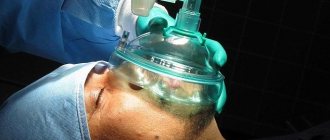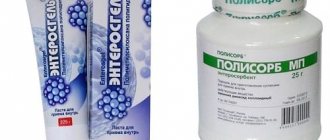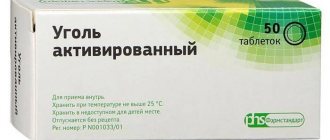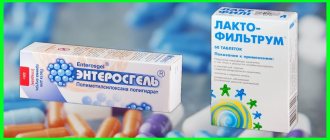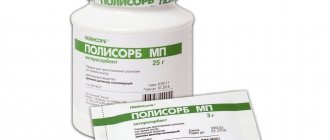With the help of adsorbents, it is possible to help the body get rid of toxic accumulations and recover faster. Thanks to the constant improvement of the pharmaceutical industry, more and more new drugs are appearing, and familiar drugs that were irreplaceable are acquiring a large number of analogues. Enterosgel, Polysorb and Activated Carbon firmly hold leading positions. To some extent, the drugs have similar characteristics, but the question always arises about Enterosgel or Activated Carbon, which is better. Let's try to figure out what is identical in the drugs and what is different.
What are adsorbents?
This term combines various medications that are taken orally for poisoning, allergic reactions or infectious processes, including food intoxication. The main property of these drugs is the ability to absorb various harmful microelements on their surface and remove them from the body. In this case, an effective enterosorbent should:
- Do not have a general effect and are excreted from the body in a pure form.
- Influence the mucous cavity of the gastrointestinal tract as little as possible, and also not spoil the normal microflora.
- Do not disrupt intestinal function, that is, do not cause constipation or diarrhea.
Which of the known adsorbents have all these properties? And what is better for the intestines: “Polysorb” or activated carbon?
The body cannot utilize or neutralize large amounts of alcohol, as a result of which the normal functioning of all organs and systems is disrupted. So, for alcohol poisoning, which is better: “Polysorb” or activated carbon?
Thanks to special enzymes, the liver converts alcohol into acetaldehyde. This substance is considered toxic and is eliminated from the body through an oxidative process, transforming into acetic acid. If a person abuses alcohol, this toxic compound can cause serious liver problems.
“Polysorb” and activated carbon help both before and after drinking alcohol. These enterosorbents have good compatibility, so they can be used at the same time, which will be a preventive measure. But in most cases, people resort to taking adsorbents after drinking alcohol, when all the negative signs of a hangover have already appeared.
How to choose?
For long-term treatment, the doctor should definitely choose Polysorb or activated carbon. However, if you take the sorbent urgently, you will have to make a decision yourself. And here it is important to remember that carbon removes everything - which means that if it is not clear what was the poisoning factor, it is better to choose Activated Carbon. If the causes of poisoning are approximately clear, and Polysorb is suitable, it is worth choosing it.
The reasons are simple:
- Polysorb does not harm mucous membranes and microflora
- Acts faster
- Does not cause constipation
- Doesn't output useful connections
- Has fewer contraindications
- Allowed for children from birth
However, in the first aid kit, just in case, it is important to have both drugs, as well as Maalox or Rennie for sudden heartburn or after mouth. Ideally, the first aid kit should also include Smecta, since its action is most directed against rotavirus. But the minimum set is Polysorb, Activated carbon and heartburn remedy.
About polysorb and activated carbon: their advantages and disadvantages
To compare Polysorb and Activated Carbon, you need to study their properties, indications, and limitations for use. The difference between Activated Carbon and Polysorb is in their forms. Activated carbon is produced in tablet forms of 250 mg. Polysorb is sold as a powder substance in plastic bottles or sachets.
Polysorb is produced in the form of a powder mass. Enterosorbent helps capture allergens, harmful substances, alcohol, bilirubin, urea, and fatty acids. Polysorb does not pass through the wall of the intestinal tube and is excreted from the body in its original form through the rectum.
Indications for use of Polysorb:
- intoxication syndrome of various etiologies;
- intestinal infectious diseases;
- purulent surgical pathologies that cause the spread of infection;
- Poisoning with strong poisons, alcohol-containing products, metals;
- Allergies to foods and medications;
- Living in unfavorable areas, working in hazardous industries;
- Increased concentration of bilirubin in the blood in liver pathologies, large amounts of nitrogen in the blood.
Polysorb is not used for ulcerative lesions of the digestive tract, bleeding from the intestinal tube, intestinal atony, or allergies to the components of the drug. Instead of Polysorb, you can choose other analogues: Activated, white carbon, Enterosgel, Enterodes, Polyphepan and other sorbents. In case of dysbacteriosis, it is allowed to use Lactofiltrum instead of Polysorb.
With the help of adsorbents, it is possible to help the body get rid of toxic accumulations and recover faster.
Thanks to the constant improvement of the pharmaceutical industry, more and more new drugs are appearing, and familiar drugs that were irreplaceable are acquiring a large number of analogues. Enterosgel, Polysorb and Activated Carbon firmly hold leading positions.
To some extent, the drugs have similar characteristics, but the question always arises about Enterosgel or Activated Carbon, which is better. Let's try to figure out what is identical in the drugs and what is different.
Activated carbon
Until recently, activated carbon was in every first aid kit. More than one generation of people has used this enterosorbent for the treatment of dyspeptic disorders. The porous surface of the drug effectively absorbs toxins and poisons from the gastrointestinal tract, binds and removes them from the body before penetrating the intestinal walls.
Enterosgel is a modern product belonging to the group of sorbents. The drug is available in the form of a gel. A pasty substance is able to envelop the inner surface of the gastrointestinal tract, come into contact with toxins, bind them and effectively remove them.
In order for the effect of Activated Carbon to occur faster and be higher, it is recommended to crush the tablets before use.
It's not always easy to swallow a few charcoal tablets, and many people experience a gag reflex due to their porous structure. Enterosgel is already ready for use.
Another special feature of the drug is that you can purchase the medicine in disposable sachets. This allows you not to be distracted by taking the drug at all. Polysorb is also ready for use.
Large sorbent particles do not have sufficient suction capacity. Black tablets have a carbon composition and a porous structure. The particles of the substance are large in size, this directly affects the efficiency and does not allow one to obtain a 100% result.
Enterosgel is a gel of homogeneous composition with pores of various sizes and high effectiveness of action on toxins and poisons.
What are the benefits of Smecta for children?
Enterosgel
Enterosgel has high functional activity and is ten times more effective than black tablets. When drugs enter the stomach, they behave differently. Enterosgel envelops the walls of the organ and protects the mucous membrane from aggressive substances. At the same time, the product effectively binds harmful substances for evacuation. This is the main differentiating effect of the drugs.
Activated charcoal works differently inside the gastrointestinal tract. After entering the stomach, the drug is unevenly distributed and does not come into contact with the entire surface. This does not change even if the black tablets have been crushed into a powder. The medicine acts fragmentarily; the effect of the drug does not extend to some areas of the organ.
Activated carbon has a heterogeneous structure with sharp edges. Because of this, the already inflamed mucous membrane is subjected to mechanical stress, and scratches, ulcerations, and foci of inflammation often appear. Therefore, Activated carbon is contraindicated for many diseases of the digestive system.
Enterosgel does not have a similar effect on the mucous membranes; on the contrary, the drug protects the organ from the appearance of microtraumas and foci of inflammation. Polysorb has a similar effect to Enterosgel, so the question about Polysorb or Activated Carbon, which is better, is quite natural.
Drugs have different effects on the body.
Let's try to look at the features of each product in more detail and determine the difference:
- Different compositions of drugs have different effects on the body. Enterosgel is made from tiny silicon compounds, and carbon tablets contain particles of charcoal, nut shells, and coal.
- When they enter the body, black tablets, along with the removal of toxic compounds and poisons, evacuate useful substances: vitamins, microelements, creating an imbalance of microflora. Enterosgel does not act aggressively on the mucous walls, but rather protects the surface. This eliminates the formation of ulcers, inflammation and damaged areas. It does not disturb the balance of microflora.
- Enterosgel leaves the body within twelve hours, removing all negative substances. Activated carbon shows a quick effect, but it takes up to two to three days to be eliminated, often causing constipation.
- Taking Enterosgel is much easier and more pleasant than Activated Carbon. The jelly-like gel is easier to take than tablets. In addition, you need to take a large number of medications at the same time: one tablet per ten kilograms of weight.
- Enterosgel can be taken at any time; as for Activated Carbon, it is taken only after gastric lavage. Only in this case the effectiveness of the product will be as high as possible.
- Enterosgel has no contraindications. The only condition when the drug is not allowed to be taken is intestinal obstruction. Activated carbon has many contraindications, and side effects often occur. All ulcerative conditions and mucosal erosions are strictly prohibited for use.
- Unlike many other sorbents, Enterosgel is not absorbed in the intestines and does not enter the blood, so it is approved for use during pregnancy and breastfeeding. It is also approved for use by newborn children from the first days of life and is well tolerated by them.
- Activated carbon turns stool a specific black color. Enterosgel does not affect the color of stool. For diagnostic purposes, this fact is of great importance.
- The cost of drugs varies. Activated carbon is much cheaper than its analogues. The drug is available to anyone. Enterosgel costs a little more, but is also quite affordable.
We invite you to familiarize yourself with Shampoos for seborrhea: good remedies for children with zinc
A variety of diseases of the colon
Activated carbon, Polysorb or Enterosgel are sorbents that have an anti-intoxication effect on the body. There are many different sorbents besides those mentioned: White coal, Enterofuril and others.
There is no point in taking several sorbents at the same time. Polysorb or Activated carbon, which is better is a question that everyone decides for themselves, even if the answer is obvious.
Choose a drug, taking into account the listed facts, and choose the appropriate option.
Characteristics of medicines
To compare Polysorb and Activated Carbon, you need to study their properties, indications, and limitations for use. The difference between Activated Carbon and Polysorb is in their forms. Activated carbon is produced in tablet forms of 250 mg. Polysorb is sold as a powder substance in plastic bottles or sachets. Activated carbon differs from Polysorb in cost. Polysorb costs from 50 rubles depending on the amount of powder. The price for activated carbon is from 20 rubles. White coal costs 150-200 rubles.
What is better for acne: Polysorb or activated carbon?
Acne and acne often indicate that waste and toxins have accumulated in the intestines. They penetrate the blood, spread throughout the body, poisoning it and causing problems with the skin. It is necessary to use “Polysorb” for acne: it will collect harmful bacteria and toxins that have accumulated in the intestines and remove them. The body will be cleansed and metabolism will improve. The source of the problem will be eliminated and the acne will disappear.
“Polysorb” refers to adsorbents. The main purpose of the medication is to eliminate toxins from the body. Under the influence of the drug, microbes stick together and die. Not only is the whole body cleansed: the organs and systems that are responsible for detoxification are unloaded. This is evidenced by reviews from doctors. Subsequently, “Polysorb” began to be increasingly used in the fight against acne, as it has proven itself well in this capacity.
Other natural medicines are also popular for their absorption properties. Similar actions, for example, have activated carbon. The differences are that such enterosorbents are used for dietary nutrition, while Polysorb is used against acne and in the form of masks. The drug applied to the surface of the skin draws out toxins from the deep layers and has a drying property.
Advantages of modern enterosorbents
So, we will now find out why all the drugs with sorbing properties on the pharmaceutical market are good. Buyers definitely pay attention to the great variety of pharmaceutical products: when purchasing enterosorbent, you can choose a dosage form suitable for an adult or a child. There are expensive drugs that provide the safest and most thorough cleansing of the body, as well as cheaper analogues that act less gently and perhaps superficially. All common cleansers can be confidently called harmless to health, of course, when used correctly. The fact is that their work does not produce any poisonous or toxic substances and, as a result, enterosorbents are completely eliminated from the body. It should also be said about the convenience of taking tablets, suspension or powder: all forms of cleansing preparations are endowed with a neutral taste and do not create difficulties when used by patients of any age. A huge list of indications indicates the possibility of using modern enterosorbents for various purposes. For example, Polysorb, Activated carbon and many other names are being introduced into a set of therapeutic measures for poisoning and allergies of various etiologies.
Activated carbon and Polysorb MP: two drugs from different price categories for effective cleansing of the body
Activated and white carbon
Activated carbon is sold in tablet forms of 250 mg. The active component of the drug is activated carbon. The medicine binds harmful substances in the intestinal cavity, removes waste products of bacterial agents and viral particles. The drug does not penetrate the intestinal wall and is excreted through the rectum in its original form. The drug is capable of capturing molecules of urea, bilirubin, fatty acids and other biological substances.
The medicine is ineffective against poisoning with alkalis and acids, iron salts, methanol, ethylene glycol. The drug does not damage the wall of the digestive tract, so it can be used in patients with diseases of the intestinal tube. Activated carbon is excreted from the intestines after 24 hours.
Indications for the use of activated carbon:
- intestinal infectious pathologies (dysentery, salmonellosis);
- drug overdose;
- pathologies of the digestive tract, dyspepsia;
- allergies to foods, medications;
- high levels of bilirubin, urea, nitrogen in the blood;
- flatulence;
- poisoning in hazardous industries.
The medicine should not be used in patients with ulcerative lesions of the digestive tract, intestinal bleeding, or intestinal atony. Charcoal is not taken simultaneously with antitoxic drugs, as it blocks their penetration through the intestinal wall. Charcoal should be used carefully in patients suffering from diabetes mellitus, as well as those following a low-carbohydrate diet. The medicine can be used in pregnant and lactating patients only as prescribed by a doctor.
An analogue of Activated carbon is white carbon. It is produced in tablet form. The active components of the drug are silicon dioxide and microcrystalline cellulose. The medicine is more effective compared to activated carbon. White coal binds harmful substances well, helps cleanse the wall of the colon, improves parietal digestion in the large intestine, and removes toxic substances from the body. The indications for prescribing the medicine are the same as for activated carbon.
White coal is not used in patients under 14 years of age, during pregnancy or breastfeeding. The drug should not be prescribed to patients with ulcerative lesions of the digestive tract, gastric and intestinal bleeding, or intestinal obstruction. The medicine is not used if you are allergic to its components.
Polisobr
The main active ingredient in the Polisorb enterosorbent is colloidal silicon dioxide. The drug has a universal effect on the body, is distinguished by its ability to remove some harmful substances, and is prescribed in certain cases.
Table 1. Purpose of Polysorb and substances affected by it
| Substances |
|
| Usage |
|
Due to the effective elimination of the causes of intoxication, Polysorb is prescribed for use as part of the complex treatment of pathological processes of various etiologies - influenza, dermatitis, colds, infectious diseases and allergic reactions.
It is recommended to use Polysobr for weight loss only after consultation with an experienced doctor. The drug should be taken with caution so as not to provoke side effects.
Contraindications
Taking Polisobr is prohibited in exceptional cases, such as:
- Peptic ulcer of the stomach or duodenum in the acute stage;
- Intolerance to the components included in the product;
- Atony (difficulty with bowel movements);
- Bleeding in the gastrointestinal tract for unknown reasons.
In cases of drug overdose, no side effects were identified. But they may appear later, especially if taking Polysorb continues for more than 14 days. These include:
- Long-term constipation;
- Rashes on the surface of the skin of allergic origin;
- Difficulty digesting food (especially solid food).
Similarities
How to choose the most effective and safe enterosorbent? “Polysorb” or activated carbon – which is better? From reviews of doctors, it is known that before getting an answer to this question, you should understand how the drugs differ and are similar.
So, the main positive qualities of these medications are:
- Effect only on the intestines, without penetration into the bloodstream.
- The composition of the drug, which does not have a harmful effect on either the kidneys or the liver.
- All medications, after consultation with a doctor, can be used during pregnancy and lactation.
We invite you to familiarize yourself with the Activated Carbon Face Mask: salvation for problem skin
The most effective enterosorbents
The following cleansing products are in demand today:
- Polysorb MP;
- Activated carbon;
- Lactofiltrum;
- Polyphepan;
- Filtrum;
- Enterosgel;
- Smecta;
- Neosmectin;
- Enterumin;
- Carbolong;
- Krabovit;
- Carbosphere;
- Sorbogel;
- Anthralen;
- Sillard P;
- Enterodesis;
- Enterosorb;
- Cholestyramine;
- Holesivilam;
- Cholestipol;
- Multisorb;
- Extralact;
- Filtrum STI;
- Algisorb;
- Zosterin;
- Mikoton.
If there is a need to cleanse the body of harmful substances, quickly cure allergies, lose weight or recover from poisoning, then purchase Activated Carbon or Polysorb. Your doctor will be able to tell you what is best, based on the condition of your body.
Doctor
What are sorbents and what drugs belong to them?
Almost every person has used sorbents at least once in their life, the list of drugs for which is extensive. Among the huge number of sorbent substances, there is a group intended for internal use. In medicine, such substances are called enterosorbents.
There are names like adsorbent or absorbent. These concepts are practically equivalent. The difference between these substances is only in the ability to absorb toxins: absorbents absorb the entire mass, and adsorbents absorb mainly a solid surface or an outer layer of liquid.
When detoxifying the body, absorbents are preferable. The hard surface of the adsorbent tablet in some cases injures the surface of the gastric mucosa.
Enterosorbents - what is it and how to take them? Sorbents are produced in the form of tablets, powder, granules, paste, capsules. What form of release to choose from the list of sorbents will be discussed below in the article.
Antisorbents must be used:
- After intestinal poisoning;
- Ingestion of heavy metals, poisons, alcohol toxins;
- In case of drug overdose;
- During “withdrawal” after drug withdrawal;
- Allergic diseases;
- Alcohol poisoning;
- Kidney failure;
- In case of poisoning due to the activity of helminths;
- Liver dysfunction;
- Overeating.
Sorbents are used both as single drugs and in combination with other drugs in complex therapy. Sorbents are also used as prophylaxis, for example, to prevent the development of cardiac ischemia.
The fact is that sorbents bind fats and do not allow them to penetrate into the bloodstream from the intestines. A person who drinks sorbent drugs gets rid of excess fat without changing his diet and without fasting. Doctors use sorbents to treat cancer patients.
What applies to sorbents:
- Silicon dioxide (TM Polysorb);
- Activated carbon (Carbopect, Sorbex);
- Dioctahedral smectite (Smecta, Endosorb, Neosmectin);
- Polymethylsiloxane polyhydrate (Enterosgel);
- Povidone (Povidone, Plasdon C 15);
- Hydrolytic lignin (Filtrum);
- Attapulgite (Neointestopan);
- Natural sorbents: bran, rice water, apple pulp, freshly squeezed vegetable juices.
Sorbents are not used without special purpose for more than 2 weeks, because these drugs remove not only toxic substances and fats, but also vital vitamins and nutrients. Long-term use may cause constipation and vitamin deficiency.
Polysorb Carbopect Sorbex Smecta Neosmectin Enterosgel Povidone-iodine Filtrum-sti Neointestopan
Among the most famous sorbents are activated carbon under various trade names, the increasingly popular Polysorb, and Smecta, a remedy for the treatment of colic and gas formation in infants.
Coal-based preparations are black; names may vary from manufacturer to manufacturer. Avexima, MS, UBF, Extrasorb are added to the main name. Carbactin, Sorbex, and Carbopect are produced based on coal.
Sorbents: preparations Method of application
| Polysorb MP | Available in the form of a white powder. Suitable for all types of poisoning. Can be used repeatedly – up to 6 times a day. |
| Activated carbon | Black charcoal in tablets of 0.25 and 0.5 mg. It is used for alcohol poisoning, when poisons, salts of heavy metals and pathogens enter the body. One of the most accessible and oldest remedies. |
| Carbolong | Black powder. Easier to use and absorbs more chemicals than charcoal. Suitable for gastritis with a high content of hydrochloric acid in the gastrointestinal tract. Long-term use leads to diarrhea and imbalance of vitamins. |
| Polyphepan | It is also called poisoning earth. In addition to its main purpose, it eliminates cholesterol when used for 4 weeks. Available in the form of a tasteless brown powder. Side effect: calcium deficiency. Can be taken from birth. |
| Filtrum | The drug is in tablets with lingin and lactulose. Treats chronic intoxication. Adults need 3 tablets a day, 1-2 for children, allergies are also treated with Lactofiltrum. |
| Smecta | The powdered product is used to get rid of diarrhea, poisoning and gastrointestinal diseases. Side effects include nutritional deficiency and impaired absorption of vitamins. |
| Sorbex | The drug is in capsules of 250 mg. Activated carbon, which prevents the intestinal absorption of alkaloids, toxic compounds, and medications. Indicated for intoxication, dysentery, allergies. Side effects include vomiting, diarrhea, and constipation. |
| Sorbolong | Capsules taken for acute food poisoning. Adults are prescribed 15 mg per day, children 5 mg. Treat within a week. |
| Enterosgel | Available in paste and gel form. Suitable for the treatment of diathesis in children. Eliminates the effects of allergies to heavy metals and toxins. Side effects: nausea, flatulence. |
| Chitosan | Made from chitin. Long-term use after chemotherapy is possible. Capsules of 500 mg are used for poisoning of varying severity. |
| White coal (silicon dioxide) | Tablets of 700 mg can be used from 3 years. White coal is drunk to get rid of the effects of dysbiosis, as well as poor nutrition. Has no side effects. |
| Linex | A drug with bifidobacteria to restore intestinal flora after long-term use of antibiotics. Helps with intestinal infections. |
| Atoxyl | Powder that removes toxins. Also prescribed for hepatitis, atopic dermatitis, diathesis. |
Activated carbon Carbolong Polyphepan Sorbolong Chitosan White carbon Linex Atoxyl
Almost all adsorbents and absorbents, when taken for a long time or in overdose, cause constipation, diarrhea, impaired absorption of nutrients, and loss of vitamins.
In addition to medications, dietary supplements are sometimes used that promise cleansing of toxins and rapid weight loss. Dietary supplements are practically not studied by specialists and have no proven effectiveness, unlike sorbents.
Each type of poisoning requires its own form of sorbent. Thus, preparations in powder form are most suitable for binding toxic substances in the stomach. To quickly cleanse the intestines, sorbents in granules are needed.
Preparations with charcoal are ideal for eliminating the effects of allergies, as well as for poisoning. However, coals have a limited effect, so such sorbents are more suitable for eliminating poisoning, which cannot be said about lingins.
Preparations with lingin, such as Lingosorb, Liferan, Polyphepan, are good for eliminating alcohol intoxication. The peculiarity of using sorbents with lingin is that you need to empty your intestines within a couple of hours after taking it, otherwise alcoholic toxins will begin to be absorbed into the blood.
Lingosorb Liferan
In cases of dysbacteriosis, treatment is carried out with prebiotics, for example, Sorbolong, Lactofiltrum, Lactobioenterosgel.
Lactofiltrum Lactobioenterosgel Pektovit
After eating a large meal, sorbents with lingin (Lingosorb and analogues), chitin (Chitosan), pectin (Pektovit), cellulose, and activated carbon are suitable.
Loading …
We invite you to familiarize yourself with Polysorb for cleansing the body: reviews. How and how much to take Polysorb sorbent to cleanse the body of acne, alcohol and toxins, and for weight loss?
Pectin sorbent
Natural pectin has a sorbing effect. It is obtained from berries, fruits and vegetables. In the gastrointestinal tract, pectin turns into jelly, which absorbs pieces of unprocessed food and pathological microorganisms. Safely removes cholesterol from the body and prevents cardiovascular diseases.
High pectin content has been found in apples, seaweed, beets, peaches, citrus fruits, watermelons, cherries, cranberries, carrots, cabbage, gooseberries, strawberries, melon, black currants, cucumbers, onions, and eggplants.
Chitin sorbent
Among sorbents, not only pectin, but also chitin is well known. It has an anti-cholesterol effect and removes harmful fatty acids. Chitin has been used as an active supplement for almost 70 years.
This sorbent is used to cleanse the blood of toxins and to prevent vascular diseases. It is indicated for excess body weight gain, diabetes mellitus, and atherosclerosis.
Before eating fatty foods, you should take 2 tablets. Chitin can be taken before meals three times a day. Preparations with chitin cause a diet effect, that is, the body essentially starves without restrictions or changes in eating behavior.
Fiber, also known as cellulose, is capable of absorbing toxins, metal salts, and pathogenic microorganisms. This sorbent creates favorable conditions for the proliferation of beneficial microorganisms inhabiting the intestine. As a result, digestion improves and the problem of dysbiosis goes away.
Take the sorbent before meals, 1 tablet twice a day, with a warm drink. Over time, the body gets used to this sorbent, so the dose is increased to 3 tablets per day.
Proper functioning of the intestines helps the body recover faster from various types of poisoning. The body needs fiber, which is contained in abundance in nuts, oatmeal, buckwheat, beans, grapes, pears, prunes, plums, apples, millet, black bread, sorrel, radishes, bananas.
These products protect the body from toxic poisoning, since they themselves act as weak sorbents. Of course, in case of severe poisoning, products will not save you from vomiting and diarrhea, but fiber helps protect a weakened body.
Sorbents are designed to help the body cleanse itself when too many toxins have entered the blood and intestines. In this case, the immune system cannot cope with foreign substances on its own. There is nothing dangerous in taking sorbents if you take them according to instructions and for no longer than a month.
Sorbents are not used in cases of individual intolerance to the components, intestinal obstruction, bleeding in the gastrointestinal tract, or exacerbation of ulcers. Almost all sorbents can be drunk during pregnancy and breastfeeding. The exception is Enterosgel. White coal is not used either. Also, you should not take Polysorb without a special purpose.
Before giving the sorbent to a child, you should make sure that the product is approved for use in childhood. Most medications can be given from birth. It is best to choose a convenient form of administration, such as powder, or grind the tablet into dust yourself.
Conclusion
When taking a sorbent (tablets, gels, powders, capsules) for a short time, you should follow the dosage and consult a doctor after taking it.
Reviews
Evgenia Komarova, 36 years old, Novosibirsk
I took Polysorb for acne for two weeks. The face quickly cleared up. A month later the problem returned again, and I decided to buy Lactofiltrum. I didn’t notice any particular effect.
Larisa Petrova, 27 years old, Moscow
Both drugs made an impression. I combined them after food poisoning. The result came quickly. Within 2 days all symptoms disappeared.
Ekaterina Solodukha, 39 years old, Kaliningrad
I gave Lactofiltrum to my daughter for diarrhea. The effect developed slowly, and I decided to buy Polysorb. I diluted it according to the instructions. Now there are no problems with my tummy.
Differences
As for the differences, the main ones will be:
- The time period after which the drug begins to have a positive effect. The fastest in this regard is “Polysorb”, which becomes active just four minutes after use.
- Impact on the intestinal mucosa. Coal, unlike its counterpart, has larger particles, which in rare situations can injure the gastric mucosa. Therefore, this medication is not recommended for use in acute gastritis or ulcers.
- Ease of use. Activated carbon is produced in tablets or capsules, which are easier and faster to consume. “Polysorb” is in the form of a powder, which should be diluted in water before use.
All these enterosorbents can absorb drugs. Therefore, if the patient is taking any additional medications, then the time interval between using the sorbent and taking them should be at least sixty minutes. So, for allergies, which is better: “Polysorb” or activated carbon? According to patient reviews, it is known that both drugs are used for allergic manifestations.
What exactly is the difference?
No matter how trivial it may sound, the difference is in the composition and mechanism of operation. Let's start with the fact that Activated carbon is a product left over from the combustion of organic compounds. It is the oldest sorbent on the planet, and is being improved every year, although in appearance it remains the same pressed black powder. Unlike coal, Polysorb is colloidal silicon dioxide, a completely inorganic compound, and its distant relative is sand.
Naturally, sorbents so different in their origin and composition cannot perform tasks in exactly the same way. The most important parameter for a modern sorbent is the operating speed. Polysorb, with its 4 minutes, clearly wins, since coal takes 15-20 minutes to begin absorbing poisons.
Another very significant point is the spectrum of action. Coal can be used to completely cleanse the stomach and intestines; it absorbs poisons, toxins, decomposition and rotting products well, and promotes degassing. Unfortunately, the effect of coal can hardly be called selective, so at the same time the body leaves the electrolytes, vitamins and microelements in the intestines, as well as part of the beneficial microflora. And most importantly, charcoal removes all water, and often leads to constipation when taken for a long time.
Polysorb, in turn, has smaller pores, into which beneficial bacteria, as well as harmful ones, no longer enter. But silicon dioxide does not remove electrolytes and interferes much less with the absorption of vitamins. In addition, the action of Polysorb stimulates peristalsis, and its composition allows this sorbent to be used even against constipation.
About polysorb and activated carbon: their advantages and disadvantages
According to reviews, both drugs take up little space, do not require certain storage conditions and are easy to take. Moreover, they can be used for almost any poisoning.
As for the problem of choice in other situations, then:
- If the patient suffers from gastritis, stomach ulcers or stool disorders, then it is better to opt for Polysorb.
- “Polysorb” is more suitable for allergy sufferers, since it has an effect quite quickly, and also helps to cope with intoxication during an infectious disease.
- “Polysorb” is suitable in a situation where a person needs to spend some period in hazardous production or in areas with poor ecology.
- If the patient does not know what exactly triggered the disease (toxins, spoiled food or bacteria), then in this case “Polysorb” is better suited, since it has a broader spectrum of action.
What are these drugs used for?
Both drugs have a sorption effect. Therefore, they are used for the following purposes:
- rapid removal of accumulated toxins and pathogenic bacteria from the intestines;
- removal of products (cholesterol, bilirubin);
- to relieve alcohol poisoning and food allergies;
- prevention of chronic intoxication in people living in poor environmental conditions.
Lactofiltrum is used primarily to normalize intestinal microflora. In addition, it also has a sorption effect.
What is better for children: Polysorb or activated carbon?
Children are more prone to intestinal infections than adults and are less susceptible to poisoning. To eliminate them, adsorbents that can quickly remove harmful substances from the body will be effective.
Not all drugs can be prescribed from infancy; for example, activated carbon is recommended only for children from seven years of age, in some cases from three. “Polysorb” is in a more advantageous position in this regard; it can be used from birth. The drug is produced in sachets of six grams, as well as in cans of 25, 50 and 100 grams. The instructions for use contain a special table, thanks to which you can easily calculate your individual dosage.
Activated carbon is not recommended for children. Coal particles injure the intestinal mucosa of children and adult patients.
Look at the price correctly
10 tablets of 0.25 g of Activated Carbon cost from 5 to 50 rubles. Polysorb packaging – 50 g for 270-320 rubles. It would seem that everything is obvious, and coal is much cheaper, but no. An adult will need from 5 to 10 tablets of coal at a time - that is, 15-25 g. At the same time, the adult dose of Polysorb is 2.5-3 g of the drug. Thus, based on rough calculations, a can of Polysorb will be enough for 17-20 days of use, and charcoal will require from 10 to 15 blisters of 10 tablets. It turns out that the price difference is no longer tens of times, but only 3-4 times.
The next point that almost all savings lovers miss in their calculations is the restoration of microflora. A pack of Linex, a package of Bifidum BAG, or even a starter for making homemade kefir will cost more than 300 rubles, so you won’t be able to save any money. But coal also removes vitamins and microelements - the most inexpensive complexes cost from 150 rubles. And it turns out that one-time savings on sorbents become very unprofitable. Moreover, Polysorb will last for a long time, but coal will not.
Selection rules
When choosing an enterosorbent, you need to understand which is better - White Coal or Polysorb. Only the attending physician should select a medication intended for long-term use, but if there is a question of quickly relieving the symptoms of poisoning, then some rules should be followed. The main condition is that Activated Carbon is capable of removing toxins and waste of any origin from the body, therefore, if it is impossible to accurately determine the causes of the pathological condition, it is necessary to take this enterosorbent.
But in cases where the exact causes of poisoning are known, it is better to give preference to Polysorb. This is due to the fact that the drug has several beneficial advantages:
- Does not have a harmful effect on the mucous membranes and intestinal microflora;
- Adsorbs faster;
- Does not cause constipation;
- Does not affect beneficial microelements;
- Has fewer contraindications;
- Suitable for use by newborns and infants.
Polysobr belongs to a new generation of drugs, therefore it carefully and carefully removes pathological microelements without causing harmful effects, but in some clinical cases it does not have the desired effect, in which case it is more advisable to take the old generation drug - Activated carbon.
Both drugs have similar pharmacological effects and quickly clear the intestines of signs of intoxication.
Reception features
The use of sorbents is determined by the attending physician, taking into account the course of the pathology and the individual characteristics of the patient’s body. The instructions indicate several diseases and a treatment regimen.
Dosage
The amount of activated carbon required for the treatment of a particular pathology is determined by a single formula - 1 tablet per 10 kilograms of human body weight.
There are many more recommendations for Polysorb. In adults, the amount of powder consumed per day is 0.1–0.2 grams per kilogram of weight. It should be mixed with half a glass of water to obtain a suspension and drunk three or four times a day.
The dose of the drug for children is calculated according to a different scheme; the details are described below in the table.
| Child's weight in kilograms | Volume in spoons | Amount of water in ml |
| to 10 | 0.5 tsp | 30–50 |
| 11–20 | 1 tsp. "no slide" | 30–50 |
| 21–30 | 1 tsp. "with a slide" | 50–70 |
| 31–40 | 2 tsp. "with a slide" | 70–100 |
| 41–60 | 1 tbsp. l. "with a slide" | 100 |
| more than 60 | 1–2 tbsp. l. "with a slide" | 100–150 |
If you have an allergic reaction to foods, drink silicon dioxide before meals. The course of treatment varies from 5 days to 2 weeks.


